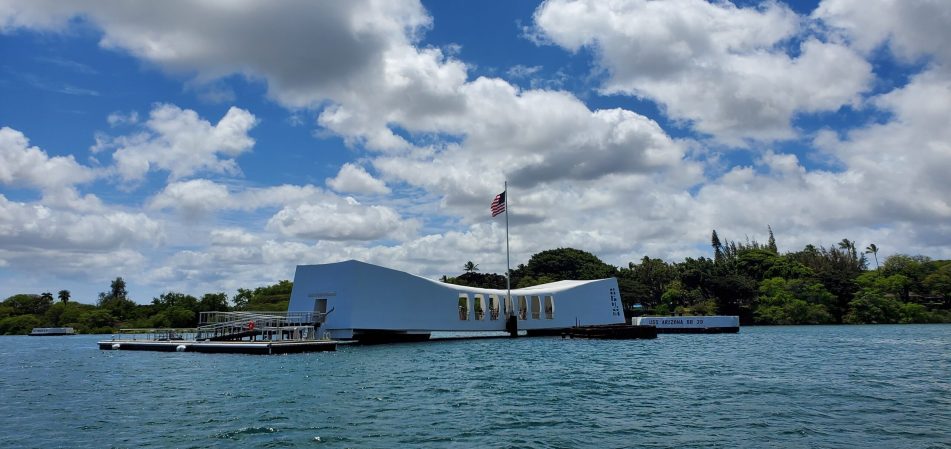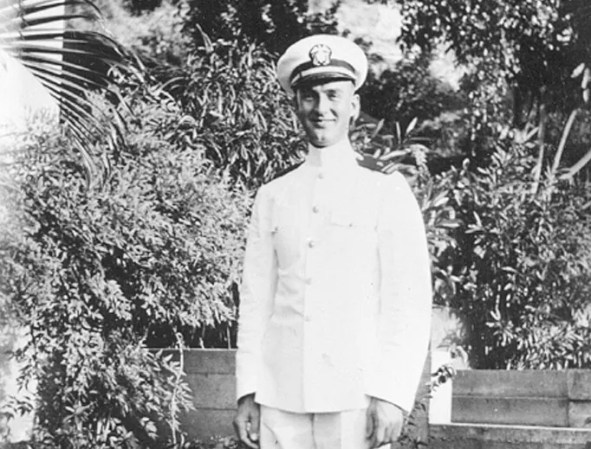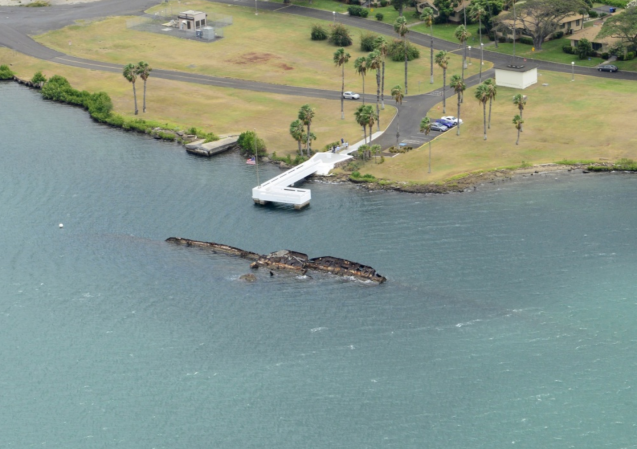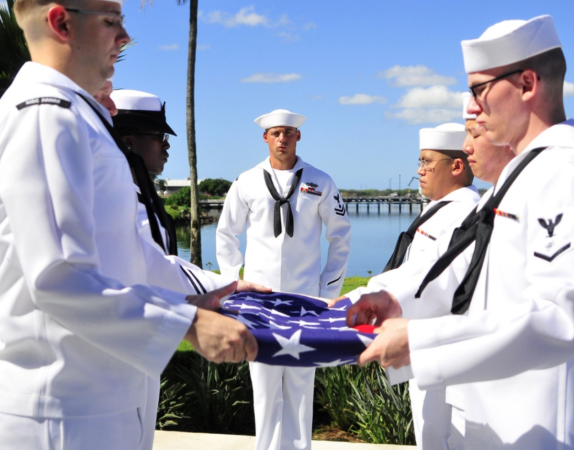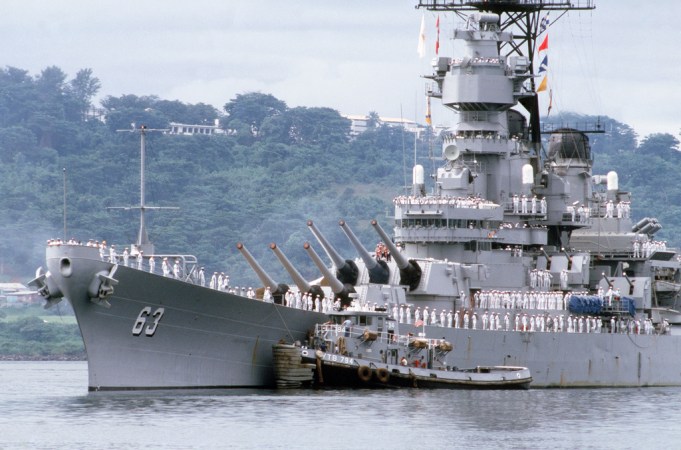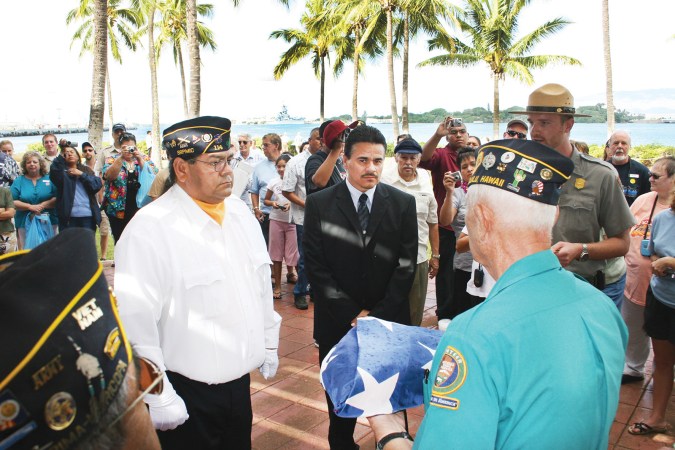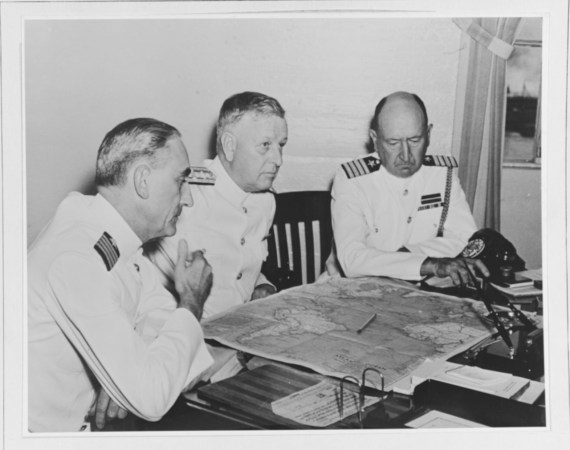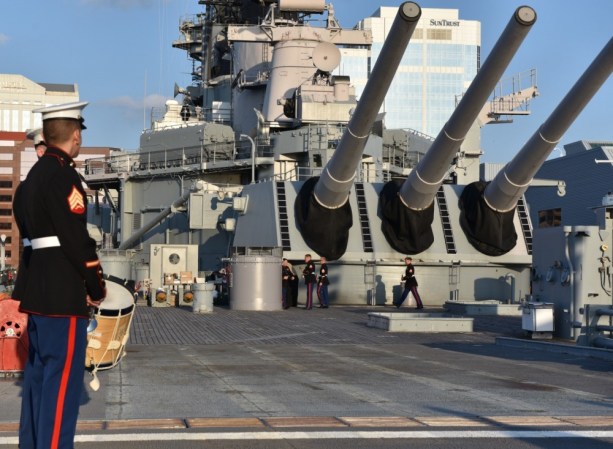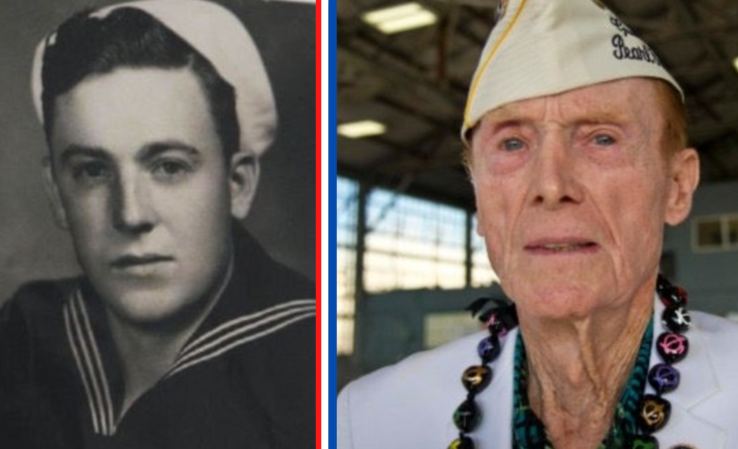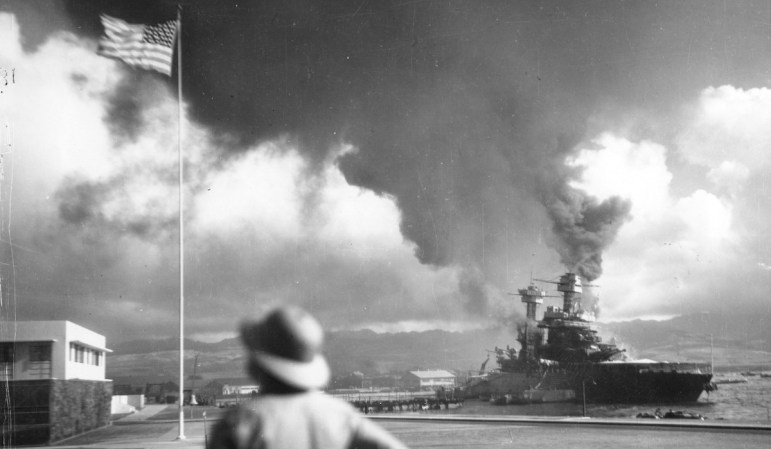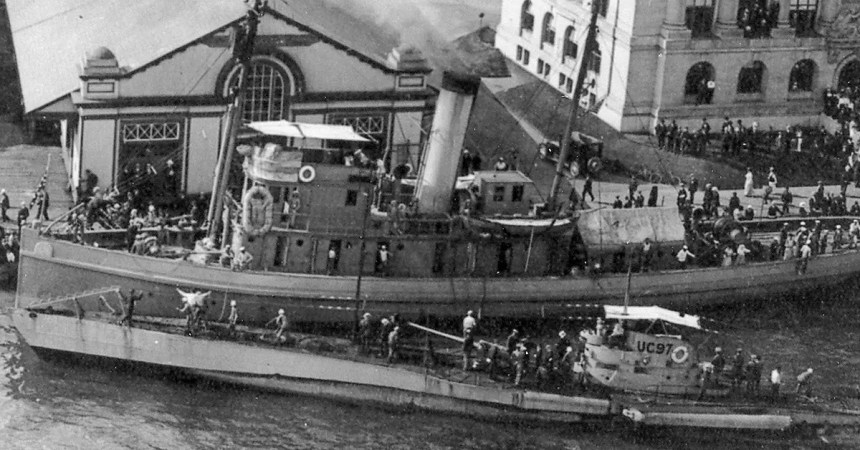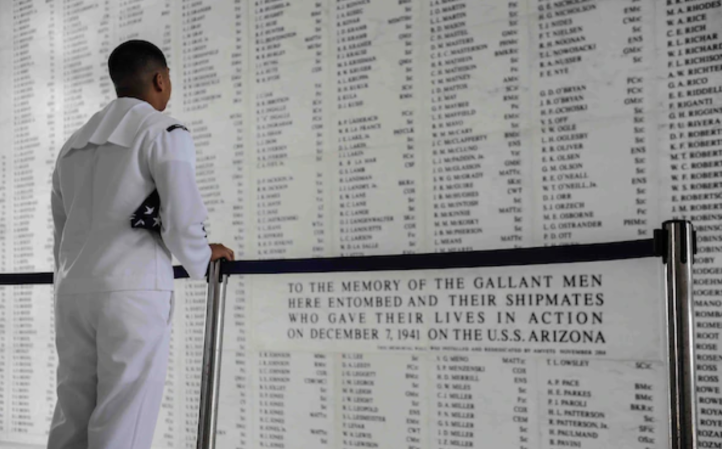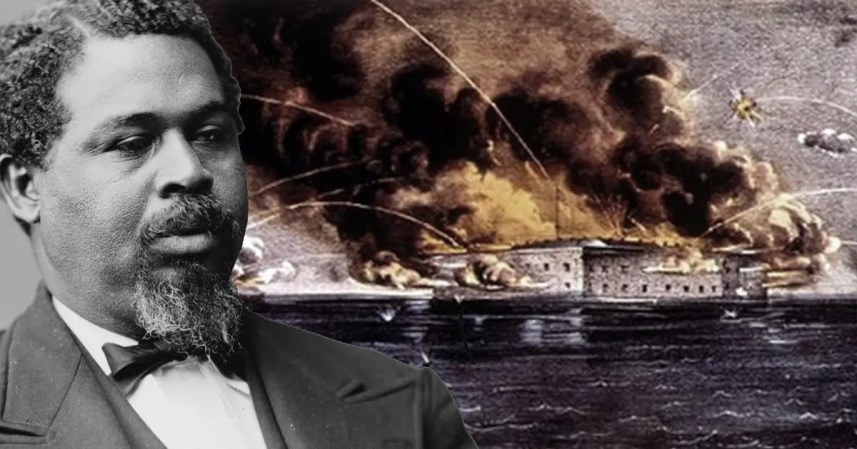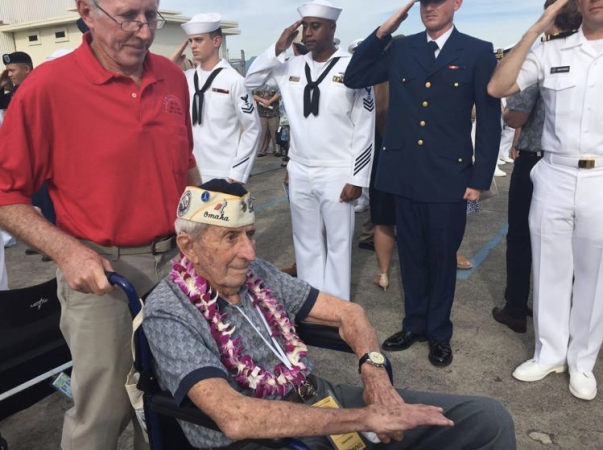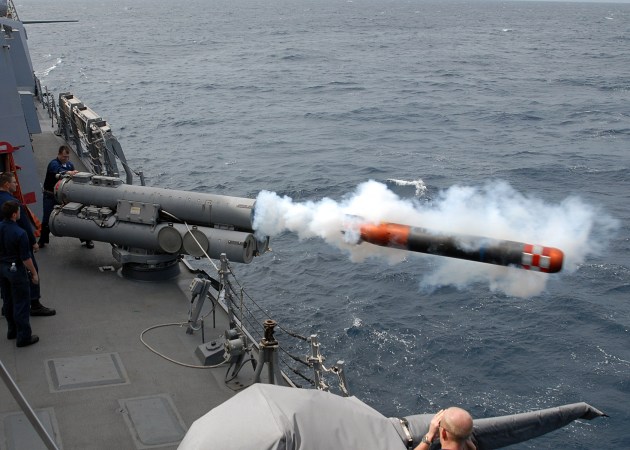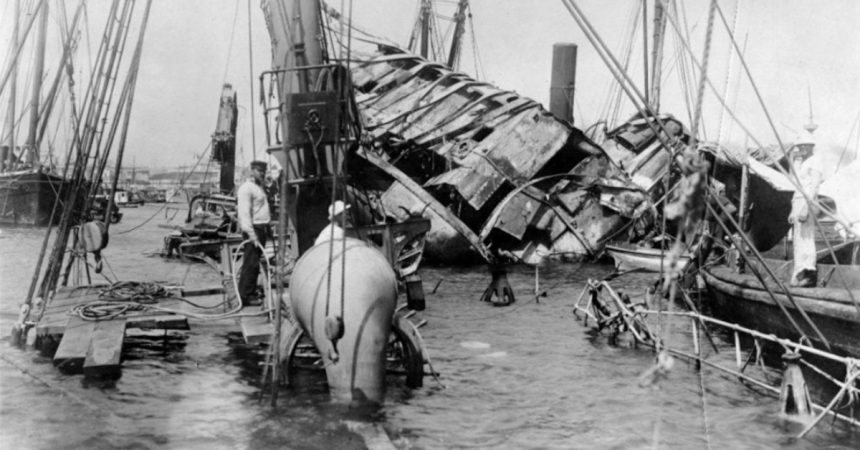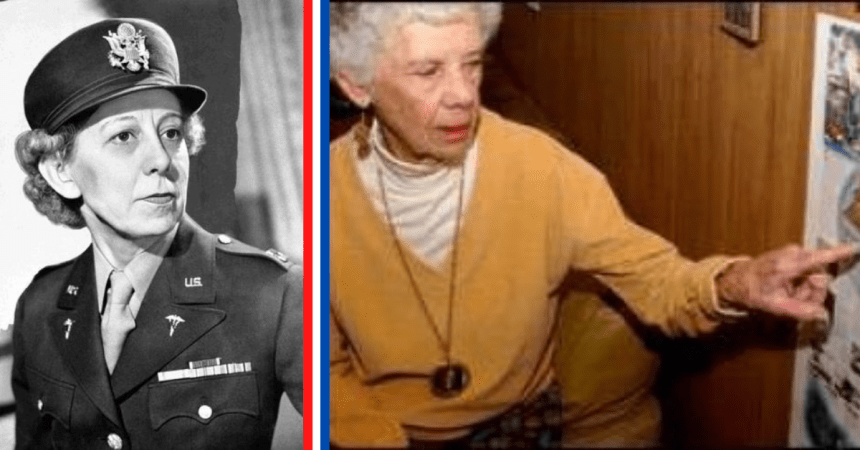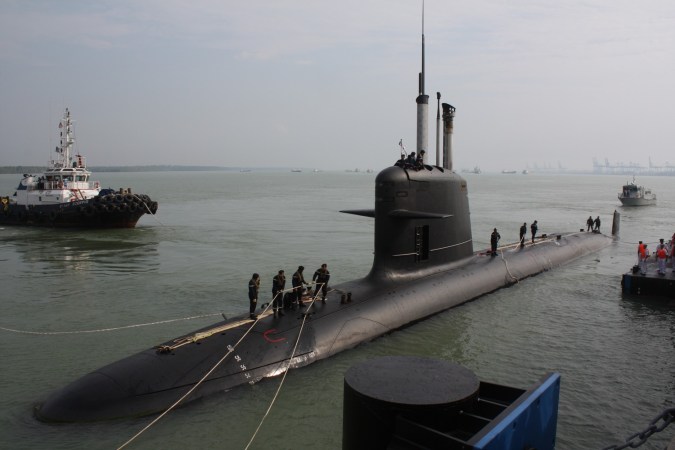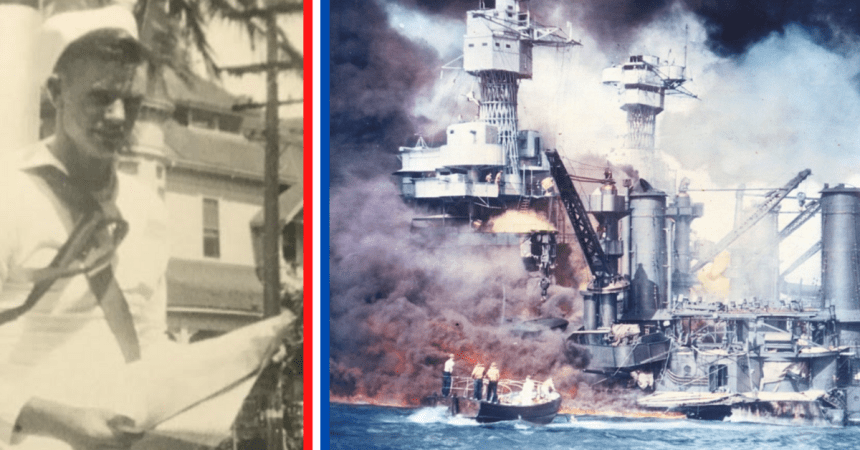The Japanese surprise attack at Pearl Harbor was meant to deal a knockout blow to the American Pacific Fleet. For all the devastation and tragic loss of life on December 7, 1941, they failed to achieve this goal. The American aircraft carriers were not at Pearl Harbor and were spared from the attack. Naval aviation played a key role in the long-range combat of the Pacific and these carriers led the U.S. counteroffensive following Pearl Harbor. Moreover, the majority of the battleships damaged at Pearl Harbor were soon repaired and returned to service.
Here is what happened to the 9 battleships at Pearl Harbor
1. USS Arizona (BB-39)

The most famous ship from Pearl Harbor, Arizona was a total loss for the Navy. She was the second and last of the Pennsylvania-class super-dreadnought battleships and one of the most powerful ships in the Pacific Fleet. On December 7, Arizona was struck by multiple bombs causing fires to break out. At 8:06, one final bomb struck near Turret II and detonated the forward magazines. The resulting explosion ripped Arizona apart and destroyed much of the interior structure of the forward part of the ship. Fires raged aboard for the next two days and 1,177 of her crew perished.
Arizona was declared temporarily out of service at Pearl Harbor on December 29. On December 1, 1942, she was struck from the Naval Vessel Register. The damage she sustained was so extensive that the Navy decided against raising and salvaging her. The ship’s remaining superstructure was scrapped in 1942 and her main armament was salvaged over the next year and a half. The aft main gun turrets were repurposed as Army Coastal Artillery Corps Battery Arizona at Kahe Point on the west coast of Oahu. Both of Arizona‘s forward turrets were left in place. However, the guns from Turret II were salvaged and installed USS Nevada (BB-36) in 1944. These guns shelled Japanese positions at Iwo Jima and Okinawa. Arizona remains sunk at Pearl Harbor with a white memorial to those who perished aboard sitting above her.
2. USS Oklahoma (BB-37)


Oklahoma was another total loss for the Navy. On December 7, she was struck by three torpedoes, the third of which penetrated her hull. Fires broke out and Oklahoma began to capsize to port. Two more torpedoes struck the mighty battleship and she completed her roll onto her side in just 12 minutes. Oklahoma‘s roll was stopped by her masts touching the bottom of the harbor. Her starboard side broke the water’s surface with part of her keel exposed. 429 of her crew were killed or missing and assumed dead.
By early 1942, the Navy decided to salvage Oklahoma as she had rolled into the harbor’s navigational channel and was a hazard. Salvaging began on July 15, 1942. After forcing water out of the ship, the righting operation began on March 8, 1943 and lasted until June 16. Human remains were removed from the ship before it was moved into drydock at Pearl Harbor on December 28. There, Oklahoma was stripped of her guns, machinery, superstructure, and remaining ammunition before she was decommissioned on September 1, 1944. On November 26, 1946, Oklahoma was sold to Moore Drydock Co. of Oakland, California for $46,127, or $654,267 in 2021. In May 1947, two tugboats towed the ship from Pearl Harbor to San Francisco Bay. However, on May 17, a storm sank Oklahoma in open water en route to San Francisco. The ship’s final resting place remains unknown.
3. USS Utah (BB-31)


Technically, Utah was no longer a battleship on December 7. In 1931, she was demilitarized, converted into a target ship, and re-designated AG-16 in accordance with the London Naval Treaty which restricted the tonnage allotted for a nation’s surface fleet. She was stripped of her primary and secondary weapons and fitted with radio controls. In June 1935, Utah was fitted with additional anti-aircraft guns to serve as a platform to train gunners. In fact, she had just completed a round of anti-aircraft gunnery training when she returned to Pearl Harbor just before December 7. During the attack, Utah was struck by two torpedoes and serious flooding caused the ship to list. At 8:12, the ship rolled completely onto her side. Fifty eight of her crew were killed.
Like Arizona, Utah was declared temporarily out of service on December 29. After Oklahoma was righted, an attempt was made to right Utah as well. However, the attempt was unsuccessful and the ship was left in her rotated state. With no military value compared to the true battleships at Pearl Harbor, no further recovery efforts were made. Utah was decommissioned on September 5, 1944 and struck from the Naval Vessel Register on November 13. She remains sunk at Pearl Harbor along with Arizona. A memorial extends from Ford Island next to the ship’s rusted hull.
4. USS West Virginia (BB-48)


West Virginia was a Colorado-class dreadnought battleship commissioned on December 1, 1923. On December 7, she was struck on her port side by seven torpedoes and hit by two armor-piercing bombs. Secondary explosions of ammo stores and spilled gasoline from the ship’s OS2U Kingfisher floatplane caused fires both on and below decks. Despite listing from the torpedo hits, prompt damage control saved West Virginia from capsizing. This allowed the ship to sink on an even keel as she filled with water. Fuel oil from nearby Arizona fed the flames aboard West Virginia that lasted until the next day. A total of 106 of her crew were killed.
West Virginia was later pumped dry and refloated on May 17, 1942. The remains of her crew who died aboard were removed and temporary repairs were made to make the ship seaworthy. Afterwards, West Virginia departed for Puget Sound Naval Shipyard, Washington for a thorough reconstruction. Limited drydock space and priority on the reconstructions of California and Tennessee meant that West Virginia was not complete until July 1944. She was fitted with air-search radar, fire-control radars, and an improved anti-aircraft weapons suite. West Virginia returned to Hawaii on September 3 where she joined Battleship Division 4. The ship fought at Leyte Gulf, Iwo Jima, and Okinawa. Although she missed much of the war during her reconstruction, West Virginia earned five battle stars during WWII. She helped ferry troops home from the Pacific before she as decommissioned on January 9, 1947 and assigned to the Pacific Reserve Fleet. West Virginia was struck from the Naval Vessel Registry on March 1, 1959 before she was sold for scrap.
5. USS California (BB-44)


California was the second of the two Tennessee-class battleships. On December 7, the ship had guns ready and immediately returned fire when the Japanese attacked as preparations were made to get underway. At 8:05, two torpedoes struck California and the ship began to flood. Water entered the fuel system and shut down the ship’s electrical system, hindering damage control efforts. As the ship listed, she was hit by two bombs which caused fires to break out. California eventually settled on the harbor floor as she slowly filled with water over the next three days. 98 of her crew were killed.
The ship was refloated on March 25, 1942, but suffered an accidental gas explosion that caused further flooding on April 5. Repairs had to be made before the ship could enter drydock on April 9. Further repairs were made and she departed for Puget Sound on October 10. There, permanent repairs and a modernization effort lasted from October 20, 1942 until January 31, 1944. California was given a wider hull, new fire control systems, and updated anti-aircraft guns. On May 5, she put to sea to join the Marianas campaign in the central Pacific. She fought through the Central Pacific campaigns, Philippines campaign, and the Battles of Leyte and Lingayen Gulf. California was decommissioned on February 14, 1947 and was struck from the Naval Vessel Registry over a decade later on March 1, 1959. She was sold for scrap on July 10.
6. USS Nevada (BB-36)


Launched in 1914, Nevada was the lead ship of her class. On December 7, the ship’s band was playing “Morning Colors” when the Japanese attack began. Not moored alongside another ship, Nevada was able to maneuver while other battleships were trapped. Although she was torpedoed, damage control counter-flooded the ship to prevent listing and Nevada got underway at 8:40. As she attempted to escape the harbor, the battleship became a prime target for Japanese bombers. Nevada was struck by six bombs which set fires across the ship. As Nevada began to flood, she made for shore and beached off Hospital Point at 10:30. 60 of her crew were killed.
On February 12, 1942, Nevada was refloated and temporary repairs were made before she sailed for Puget Sound. Repairs and a modernization overhaul were complete in October 1942. Nevada sailed for Alaska to provide fire support for the capture of Attu from May 11-18, 1943. In June, Nevada sailed to Norfolk for further modernization. Afterwards, she began Atlantic convoy duty until she sailed for the UK in preparation for D-Day. During the Normnady invasion, Nevada shelled German positions on the Cherbourg Peninsula with extreme precision, sometimes just 600 yards in front of friendly positions. She was the only battleship present at both Pearl Harbor and D-Day. Nevada then provided fire support for Operation Dragoon, the amphibious landings at Toloun in southern France, before sailing for New York. There, she was refitted with guns from Arizona and sailed for the Pacific. Nevada provided fire support at Iwo Jima and Okinawa before the war ended. She was later used in the Bikini Atoll atomic experiments in 1946 and was sunk as a target ship in 1948. Her wreck was discovered 65 nautical miles southwest of Pearl Harbor on May 11, 2020.
7. USS Pennsylvania (BB-38)


Pennsylvania was the lead ship in her class of super-dreadnought battleships. On December 7, she was in drydock undergoing a refit next to two destroyers. Japanese planes attempted to torpedo the side of the drydock to flood it but failed. Pennsylvania was hit by one bomb as well as debris from one of the destroyers. In total, 15 of her crew were killed with another 14 missing presumed dead. Pennsylvania was only lightly damaged compared to the other battleships at Pearl Harbor and put to sea on December 12. She arrived in San Francisco for repairs on December 29 and was fully operational on January 12, 1942.
Pennsylvania put to sea during the Battle of Midway but did not see combat. However, she did fight during the Aleutian Islands campaign, the Battle of Makin, the Marshall Islands campaign, the Marianas campaign, and the Philippines campaign. On August 12, 1945, a Japanese torpedo bomber penetrated the Allied defensive screen at Buckner Bay in Okinawa and launched its torpedo at Pennsylvania. The torpedo struck the ship’s aft and caused serious damage. Flooding was contained, but 20 men were killed. Pennsylvania was the last major U.S. warship damaged during WWII. After the war, she took part in the Bikini Atoll atomic tests before she was decommissioned on August 29, 1946. Various radiological and structural studies were conducted on her until she was scuttled off Kwajalein on February 10, 1948. Interestingly, Pennsylvania was not struck from the Naval Vessel Registry until February 19.
8. USS Tennessee (BB-43)


Tennssee was the lead ship of her class of dreadnought battleship. On December 7, her crew began fighting back just five minutes after the attack started. Although she was ordered to get underway, Tenneesse was blocked in by the other battleships around her that were heavily damage including Arizona and Oklahoma. The explosion that ripped apart Arizona showered Tennessee with burning oil. Along with oil leaking from West Virginia, Tennessee was quickly engulfed in flames. During the attack, she was hit by two bombs, neither of which caused serious damage compared to the ships around her. Five of her crew were killed.
Although Tennessee was only lightly damaged, she remained trapped where she was moored by sunken battleships. She was finally towed out on December 16 and received repairs at Pearl Harbor before sailing for Mare Island Naval Shipyard on December 20. Tennessee received new hull plating and electrical wiring as well as new primary and secondary guns. She returned to service in February 1942 but was sent to Puget Sound to be modernized alongside California in August. The overhaul took nearly a year and she sailed to join the Aleutian Islands campaign on May 22, 1943. Tennessee went on to fight across the Pacific from the Gilbert and Marshall Islands all the way to the Philippines, Iwo Jima, and Okinawa. Over the course of the war, she fired 9,347 14-inch shells from her main battery, 46,341 5-inch shells from her secondary guns, and more than 100,000 rounds from her anti-aircraft batteries. Nearly 30 years old, the battleship was assigned to the reserve fleet in 1946 and decommissioned on February 14, 1947. On March 1, 1959, she was struck from the Naval Vessel Register and sold for scrap on July 10.
9. USS Maryland (BB-46)


Maryland was the flagship of the fleet and was moored inboard of Oklahoma on December 7. This shielded her from torpedo attack and allowed the crew to bring all of her anti-aircraft batteries into action. Maryland‘s crew was augmented by survivors from Oklahoma who abandoned their sinking ship and eagerly supported Maryland‘s anti-aircraft defenses. Two bombs penetrated the ship’s deck and caused flooding, but did not endanger the ship. Maryland continued to return fire as her crew sent out firefighting and rescue parties to nearby ships. Four of crew were killed during the attack.
After Pearl Harbor, the Japanese erroneously reported that Maryland had been sunk. In fact, the damaged ship sailed into Puget Sound just behind Tennessee on December 30 for repairs. She was repaired, overhauled, and fitted with new guns before returning to service on February 26, 1942. She stood guard over the west coast during the Battle of Midway. Afterwards, Maryland patrolled the Fijian Islands with Colorado, which had been undergoing an overhaul at Puget Sound on December 7. The two battleships went on to patrol around New Hebrides, Espiritu Santo, and Aore Island. Maryland provided fire support during the Battles of Tarawa, Kwajalein, Saipan, Leyte Gulf, and Okinawa. After the war, she ferried over 8,000 troops back to the states. The ship was transferred to the reserve fleet on July 16, 1946 and was decommissioned on April 3, 1947. Maryland was sold for scrap on July 8, 1959.



